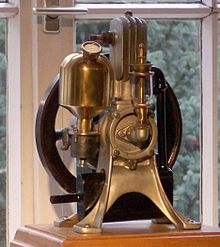Hugo Ruppe

Hugo Ruppe (born August 15, 1879 in Apolda ; † January 23, 1949 in Gornau / Erzgeb. ) Was a German mechanical engineer , entrepreneur and automobile pioneer.
Life
After studying mechanical engineering at the Ilmenau technical center, Hugo Ruppe worked in his father's company in Apolda - A. Ruppe & Sohn , converted to a stock corporation in 1904 and renamed Apollo-Werke AG in 1912 after the Ruppe family left . There he developed inexpensive automobiles, the Apollo and Piccolo types . As early as 1903 he presented his first self-developed motorcycle, the Apoldiana .

Ruppe left the family business in 1907 after differences of opinion with his brothers and founded the Markranstädter Automobilfabrik Hugo Ruppe (MAF) in Markranstädt . The company produced small cars with air-cooled four-stroke engines.
Hugo Ruppe was a good engineer, but a bad businessman. As early as 1911, his company was facing financial failure and had to file for bankruptcy. MAF was bought up by a group of investors, Ruppe continued to work as technical director and chief designer. For its reputation as a designer also talks that the company after the restructuring of the company formerly Hugo Ruppe Markranstädter Automobilfabrik GmbH (MAF) was continued. During this time, Ruppe also made his first experiments with two-stroke engines and flywheel ignition magnets .
When the First World War broke out in 1914, he was called up for military service. After his return from the front, he did not return to Markranstädt in 1918, but went to Zschopau . There he worked in the Zschopauer Maschinenfabrik JS Rasmussen and offered Jørgen Skafte Rasmussen 's two-stroke engine, the under the symbol " DKW " (for " D is K hub W unsightly") as a modern alternative to toy steam engine was quite successfully marketed. Bestseller of 1921 was the further development of the toy motor, enlarged and production-ready one-horsepower bicycle auxiliary engine in the DKW now for " D as K leash W was under" for "... drives uphill like others down with the slogan! “Was advertised and of which more than 10,000 pieces could be sold in 1921 alone. Despite the success of his auxiliary bicycle motor built in Zschopau, Ruppe initially separated from Rasmussen in 1922, went to Berlin and founded the Bekamo . Two-stroke engines with piston charging pumps , light metal cylinders with gray cast iron liners , light metal pistons, removable aluminum cylinder heads and an original purge air control were built here. At the time, these engines were by far the most powerful two-stroke engines, but they were very complex to manufacture. As a result of the high costs, this company was also unsuccessful and had to be given up in 1925.
After a short stint at Metallwerke Frankenberg GmbH (predecessor of Framo ) in Frankenberg , founded by Jørgen Skafte Rasmussen as a subsidiary and supplier , Hugo Ruppe founded a new company under the name Kaehlert & Ruppe in Festenberg in Silesia . In the wake of the global economic crisis , this too had to be given up in the early 1930s. Ruppe survived the turmoil of the Second World War and sought refuge in Zschopau at the end of the war. His efforts to start the production of small emergency power generators there failed. Ruppe died impoverished and lonely in 1949.
meaning
Presumably during the First World War, Hugo Ruppe designed a two-stroke explosion engine with 18 cm³ and 0.25 hp, intended as a toy engine . He built this motor at the Zschopauer machine factory JS Rasmussen under the name Des Knaben Wunsch (DKW). The further development of the auxiliary bicycle motor with 118 cm³ under the name Das Kleine Wunder helped DKW achieve a breakthrough - in 1928 the company was the largest motorcycle factory in the world.
Patent applications
His patented inventions include a flywheel igniter, a bicycle drive with a rotating boxer engine, but also a "pump system, especially for blasting garden beds".
literature
- Siegfried Rauch, Frank Rönicke: Men and Motorcycles. A century of German motorcycle development. Motorbuch-Verlag, Stuttgart 2008, ISBN 978-3-613-02947-7 , pp. 180-187.
| personal data | |
|---|---|
| SURNAME | Ruppe, Hugo |
| BRIEF DESCRIPTION | German mechanical engineer and engine designer |
| DATE OF BIRTH | August 15, 1879 |
| PLACE OF BIRTH | Apolda |
| DATE OF DEATH | January 23, 1949 |
| Place of death | Gornau / Erzgeb. |
